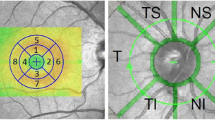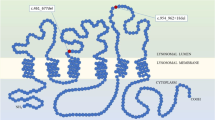Abstract
Nineteen obligate heterozygotes, 8 individuals at risk of being heterozygote, and 10 patients afflicted with four different forms of neuronal ceroid lipofuscinosis were examined electrophysiologically. The group of obligate heterozygotes was compared to age-matched control groups. Statistically significant differences were found between scotopic b-wave amplitudes, P-ERG amplitudes, and EOG light peaks of the obligate carriers of the juvenile type and the control subjects. The photopic L-ERGs and the latencies of the VEPs were mostly within the normal range. The findings represent the first evidence of functional ophthalmological changes in obligate carriers of neuronal ceroid lipofuscinosis and demonstrate that heterozygotes with certain hereditary autosomal recessive diseases may manifest subtle functional signs.
Similar content being viewed by others
References
Arden GM, Carter RM, Hogg C, Siegel IM, Margolis S (1979) A gold foild electrode: extending the horizons for clinical electroretinography. Invest Ophthalmol Vis Sci 18:421–426
Boers GHJ, Smals AGH, Trijbels FJM, Fowler B, Bakkeren JAJM, Schoonderwaldt RC, Kleijer WJ, Kloppenborg PWC (1985) Heterozygosity for homocystinuria in premature peripheral and cerebral occlusive arterial disease. N Engl J Med 12:709–715
Christomanou H, Martinius J, Jaffe S, Betke K (1980) Biochemical, genetic, psychometric, and neuropsychological studies in heterozygotes for various lipidoses. Hum Genet 55:103–110
Christomanou H, Jaffe S, Martinius J. Cap C, Betke K (1981) Biochemical, genetic, psychometric, and neuropsychological studies in heterozygotes of a family with globoid cell leukodystrophy (Krabbe's disease). Hum Genet 58:179–183
Ernst W, Moore AT (1987) Heterogeneity, anomalous adaptation and incomplete penetrance in autosomal dominant retinities pigmentosa. Adv Biosci 6:115–128
Goebel HH, Fix JD, Zeman W (1974) The fine structure of the retina in neuronal ceroid-lipofuscinosis. Am J Ophthalmol 77:25–39
Goebel HH, Zeman W, Damaske E (1977) An ultrastructural study of the retina in the Jansky-Bielschowsky type of neuronal ceroid-lipofuscinoses. Am J Opthalmol 83:70–79
Goebel HH, Zeman W, Patel VK, Pullarkat RK, Lenard HG (1979) On the ultrastructural diversity and essence of residual bodies in neuronal ceroid-lipofuiscinosis. Mech Ageing Dev 10:53–70
Goebel HH, Koppang N, Zeman W (1979) Ultrastructure of the retina in canine neuronal ceroid-lipofuscinosis. Ophthalmic Res 11:65–72
Goebel HH, Köhnecke B, Koppang N, Armstrong D (1982) Ultrastructural studies on the retinal pigment epithelium in the neuronal ceroid-lipofuscinoses. Ophthalmic Pediatr Genet 3:29–37
Griff ER, Steinberg RH (1982) Origin of the light peak: in vitro study of gekko gekko. J Physiol 331:637–652
Groneberg A, Teping C (1980) Topodiagnostic von Sehstörungen durch Ableitung retinaler and kortikaler Potentiale auf Umkehr-Kontrastmuster. Ber Dtsch Ophthalmol Ges 77:409–417
Ikeda K, Goebel HH (1979) Ultrastructural pathology of human lymphocytes in neuronal ceroid-lipofuscinosis. Brain Dev 1:285–292
Lake BD, Cavanagh NPC (1978) Early-juvenile Batten's disease. J Neurol Sci 36:265–271
Maffei L, Fiorentini A, Pirchio M, Spinelli D, Porchiatti V (1981) The ERG in response to alternating gratings in patients with disease of the peripheral visual pathway. Invest Ophthalmol Vis Sci 24:490–493
Newman EA, Odette LL (1984) Model of electroretinogram b-wave: a test of the K-hypothesis. J Neurophysiol 51:164–182
Nilson SEG, Armstrong D, Koppang N, Person P, Milde K (1983) Studies on the retina and the pigment epithelium in hereditary canine ceroid-lipofuscinosis. Invest Ophthalmol Vis Sci 24:77–84
Polak BCP, Lith FHM van, Delleman JW, Balen ATM van (1983) Carrier detection in tapetoretinal degeneration in association with medullar cystic disease. Am J Ophthalmol 95:487–494
Stambolian D, Scorpino-Myers V, Eagle RC Jr, Hodes B, Harris H (1986) Cataracts in patients heterozygous for galactokinase deficiency. Invest Ophthalmol Vis Sci 27:429–433
Zeman W, Dyken P (1969) Neuronal ceroid-lipofuscinosis (Batten's disease) — Relationship to amaurotic family idiocy. Pediatrics 44:570–583
Zetterström B (1951) The ERG of children during the first year of life. Acta Ophthalmol 29:295–301
Zrenner E, Baker CL, Hess RF, Olson B (1986) Current source density analysis of linear and non-linear components of the primate electroretinogram. Invest Ophthalmol Vis Sci [Suppl] 27:242
Author information
Authors and Affiliations
Additional information
This study was supported by the Deutsche Retinitis Pigmentosa Gesellschaft and the Deutsche Forschungsgemeinschaft.
Rights and permissions
About this article
Cite this article
Gottlob, I., Leipert, K.P., Kohlschütter, A. et al. Electrophysiological findings of neuronal ceroid lipofuscinosis in heterozygotes. Graefe's Arch Clin Exp Ophthalmol 226, 516–521 (1988). https://doi.org/10.1007/BF02169198
Received:
Accepted:
Issue Date:
DOI: https://doi.org/10.1007/BF02169198




